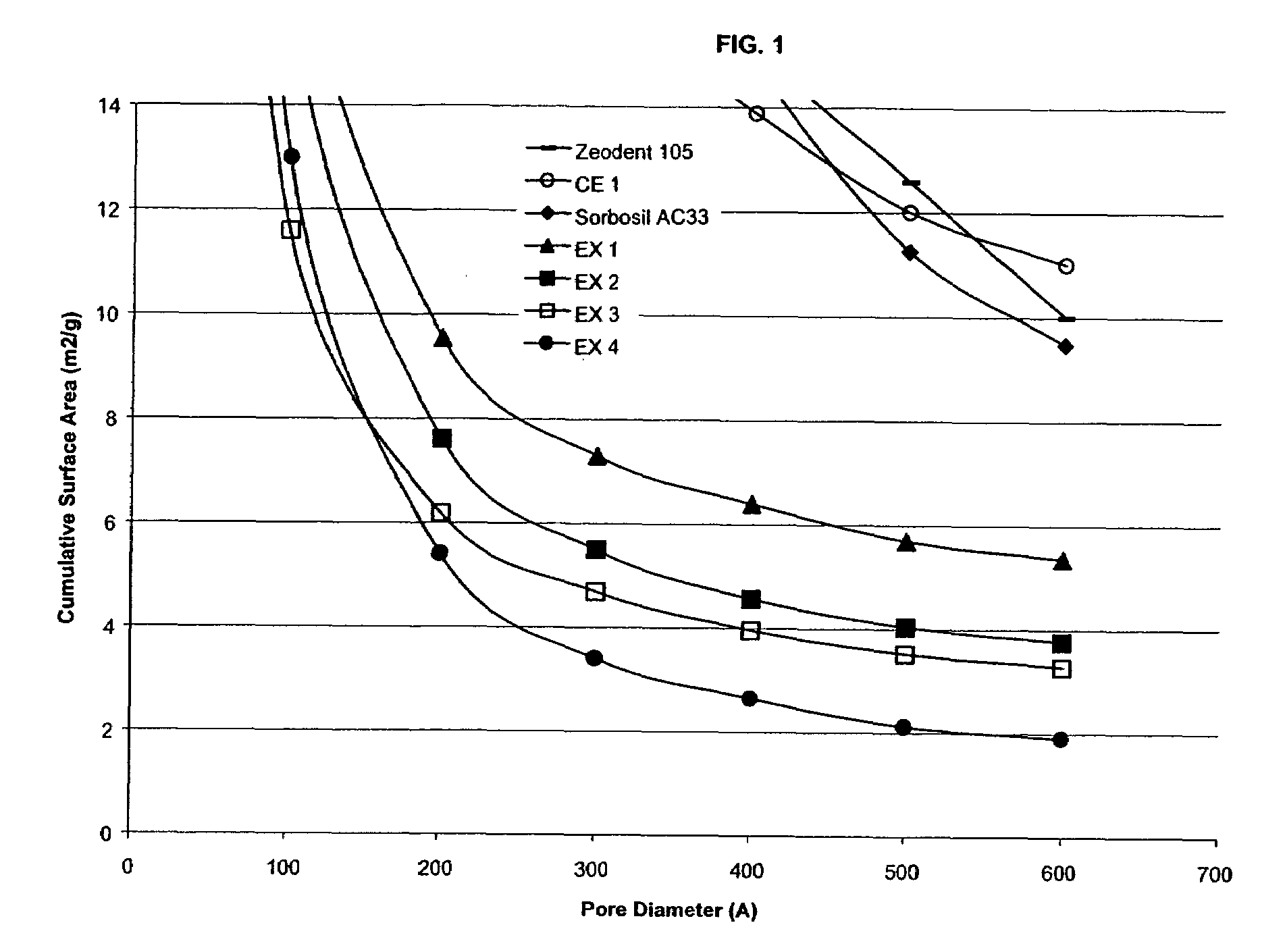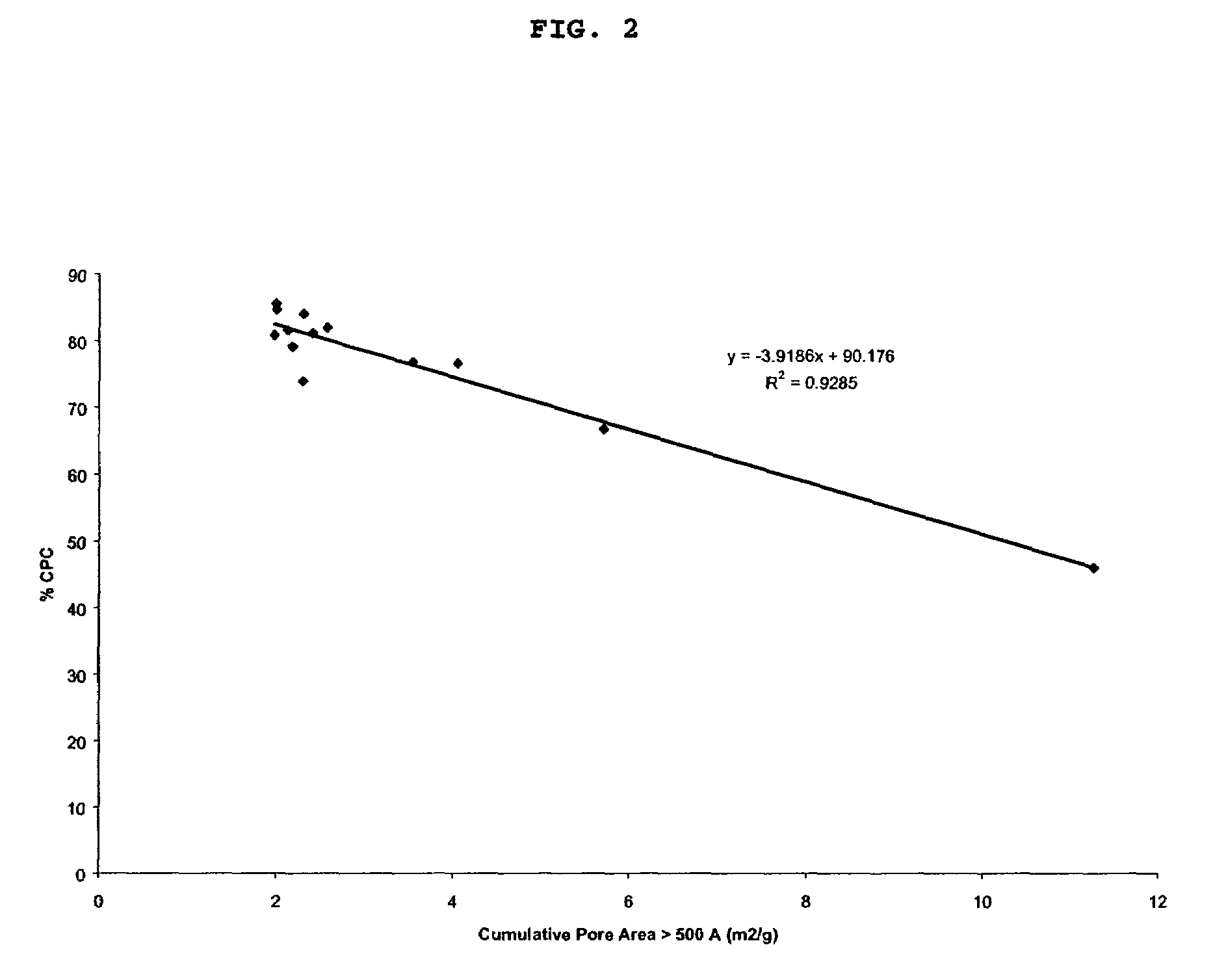Precipitated silica product, dentifrices containing same, and processes
a technology of amorphous silica and dentifrice, which is applied in the field of precipitation amorphous silica and processes, can solve the problems of cpc being indiscriminately bind to negatively charged surfaces, cpc being generally unavailable to perform any meaningful antimicrobial action, and adsorption of cpc upon silica or other co-ingredients of the dentifrice is highly undesirable, so as to redu
- Summary
- Abstract
- Description
- Claims
- Application Information
AI Technical Summary
Benefits of technology
Problems solved by technology
Method used
Image
Examples
example 1
[0076]63 L of bead milled silica substrate particles (˜33.55 % solids) were added to a 400 gallon reactor along with 265 L of water. The slurry was heated to 95° C. with stirring at 78 RPM. Once a temperature of 95° C. was reached, sodium silicate (13.3%, 2.65 M.R. pre-heated to 90° C., 1.123 g / ml S.G.) was added at 3.6 L / min until pH 9.5 was reached. Once a pH of 9.5 was reached, sulfuric acid (11.4%) was added at ˜1.9 L / min in order to maintain this pH. If necessary, the acid flow rate was adjusted to maintain pH 9.5. After 150 minutes, the silicate flow was stopped and the pH was adjusted to 5.0 with the addition of sulfuric acid at 3.8 L / min. Once a pH of 5.0 was reached, the flow of acid was stopped and this pH was maintained for a period of 10 minutes. The reaction mixture was then filtered, washed with water until a conductivity of <1500 μS, and then spray dried.
example 2
[0077]43 L of bead milled silica substrate particles (˜33.55 % solids) were added to a 400 gallon reactor along with 180 L of water. The slurry was heated to 95° C. with stirring at 78 RPM. Once a temperature of 95° C. was reached, sodium silicate (13.3%, 2.65 M.R., pre-heated to 90° C., 1.123 g / ml S.G.) was added at 4.7 L / min until a pH of 9.5 was reached. Once a pH of 9.5 was reached, sulfuric acid (11.4%) was added at ˜2.2 L / min in order to maintain this pH. If necessary, the acid flow rate was adjusted to maintain a pH of 9.5. After 30 minutes the flow of silicate was adjusted to 4.5 L / min and the flow of acid to ˜2.2 L / min. After 60 minutes the flow of silicate was adjusted to 4.2 L / min and the flow of acid to ˜2.0 L / min. After 90 minutes the flow of silicate was adjusted to 3.6 L / min and the flow of acid to ˜1.7 L / min. After 120 minutes the flow of silicate was adjusted to 3.1 L / min and the flow of acid to ˜1.5 L / min. After 150 minutes, the silicate flow was stopped and the pH...
example 3
[0078]33 L of bead milled silica substrate particles (˜33.55% solids) were added to a 400 gallon reactor along with 138 L of water. The slurry was heated to 95° C. with stirring at 78 RPM. Once a temperature of 95° C. was reached, sodium silicate (13.3%, 2.65 M.R., pre-heated to 90° C., 1.123 g / ml S.G.) was added at 5.1 L / min until a pH of 9.5 was reached. Once a pH of 9.5 was reached, sulfuric acid (11.4%) was added at ˜2.4 L / min in order to maintain this pH. If necessary, the acid flow rate was adjusted to maintain a pH of 9.5. After 30 minutes the flow of silicate was adjusted to 4.9 L / min and the flow of acid to ˜2.3 L / min. After 60 minutes the flow of silicate was adjusted to 4.5 L / min and the flow of acid to ˜2.2 L / min. After 90 minutes the flow of silicate was adjusted to 4.0 L / min and the flow of acid to ˜1.9 L / min. After 120 minutes the flow of silicate was adjusted to 3.5 L / min and the flow of acid to ˜1.7 L / min. After 150 minutes, the silicate flow was stopped and the pH ...
PUM
| Property | Measurement | Unit |
|---|---|---|
| surface area | aaaaa | aaaaa |
| BET specific surface area | aaaaa | aaaaa |
| median diameter | aaaaa | aaaaa |
Abstract
Description
Claims
Application Information
 Login to View More
Login to View More - R&D
- Intellectual Property
- Life Sciences
- Materials
- Tech Scout
- Unparalleled Data Quality
- Higher Quality Content
- 60% Fewer Hallucinations
Browse by: Latest US Patents, China's latest patents, Technical Efficacy Thesaurus, Application Domain, Technology Topic, Popular Technical Reports.
© 2025 PatSnap. All rights reserved.Legal|Privacy policy|Modern Slavery Act Transparency Statement|Sitemap|About US| Contact US: help@patsnap.com


